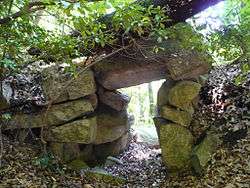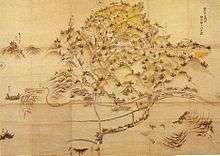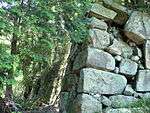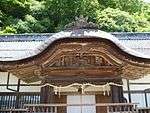Kannonji Castle
| Kannonji Castle | |
|---|---|
| (観音寺城) | |
| Azuchi, Shiga Prefecture, Japan | |
 | |
 Kannonji Castle | |
| Coordinates | 35°08′46″N 136°09′28″E / 35.146027°N 136.157778°E |
| Type | Mountain castle (山城) |
| Site information | |
| Controlled by | Azuchi, Shiga |
| Open to the public | yes |
| Condition | Ruins |
| Site history | |
| Built | 1468 |
| Built by | Rokkaku clan |
| In use | 1468 – 1582 |
| Materials | Stone, wood |
| Battles/wars | Onin War |
| Events | Visited by Oda Nobunaga (1568) |
The ruins of Kannonji Castle (観音寺城 Kannonji-jō) are on the ridgeline of Mount Kinugasa in the town of Azuchi, Shiga Prefecture, not far from the ruins of Azuchi Castle. At the site, the ruins of stone walls, a stone-lined well, and a historical signboard can be found. The castle was named after Kannonsho-ji, a Buddhist temple near the peak of the mountain.
History

During the Sengoku period, the Sasaki (佐々木) family (or Rokkaku clan) was appointed constabulary authority over Ōmi and other nearby provinces by the Ashikaga shogunate in Kyoto. A castle was needed as an administrative center and military rallying point. The ridged peak of Kinugasa Mountain, where Kannonsho-ji was already, was selected as the new site. A castle from that lofty position would command a view of the plains below and would serve as a symbol of power in the region. Construction was completed in 1468; it was originally named Sasaki Castle.
Sasaki (now Kannonji) Castle was intended to defend Ōmi Province and was the base-castle of the Rokkaku clan.[1][2] It was attacked and taken not long after construction during the Ōnin War (1467–77).
Renovations were done during the Kōji Era (1555–1558), and the stone ramparts were enlarged to accommodate small cannons.[2]
In 1568, Oda Nobunaga was escorting Ashikaga Yoshiaki to Kyoto to install him as shōgun.[3] As the expedition crossed through the area, Rokkaku forces, loyal to the Ashikaga shogun, left their stronghold to disrupt or arrest their advance. Nobunaga defeated the Rokkaku on the battlefield[4] and entered Kannonji Castle unopposed and in triumph, before resuming his march to Kyoto.
The Rokkaku clan continued to use Kannonji Castle as a base castle until their worst defeat in 1570 by Shibata Katsuie.[4] It is thought that the castle was abandoned sometime afterward.[2] In 1582 Kannonji Castle was attacked and burned, along with Azuchi Castle, possibly at the hands of looters from among the local peasantry.
In 1969 and 1970, artifacts were discovered during archaeological excavations in the main courtyard (hon-maru).[2]
Significance
Kannonji Castle is regarded as among Japan's Five Greatest Mountain Castles, along with Kasugayama Castle, Nanao Castle, Odani Castle and Gassantoda Castle.[1]
Access
If hiking, the trail head that leads up the west side of Kinugasa Mountain (433m) is about a 25-minute walk from Azuchi Station, or about 10 minutes from the nearby Azuchi Castle Archaeology Museum and the Nobunaga Hall. The trail leads up the west side of the mountain, first to the ancient temple Kuwanomi-dera (桑実寺), then through a forest of Japanese cedars, and up to Kannonji Castle site. From the main courtyard, there is a trail leading on to Kannonsho-ji, a temple with an impressive panoramic view.
If driving, there are two roads that lead up the mountain. One follows a spur on the southwest slope and is accessed near the Nakasendō Highway (Japan National Route 8) in Azuchi. The other leads up the eastern slope, and can be found near Route 202 off the Nakasendō Highway in the neighboring town of Gokashō. Both roads lead to Kannonsho-ji, a few minutes' walk from Kannonji Castle ruins.
Gallery
References
| Wikimedia Commons has media related to Kannonji Castle. |
- 1 2 Motoo, Hinago (1986). Japanese Castles. Tokyo: Kodansha. pp. 200 pages. ISBN 0-87011-766-1.
- 1 2 3 4 Harada, Toshimaru; Watanabe, Morimichi (1972). 滋賀県の歴史 [History of Shiga Prefecture] (in Japanese). Hikone, Japan: Yamagawa Publishers. ASIN B000J9GH22.
- ↑ Sansom, George (1961). A History of Japan: 1334–1615. Stanford, CA: Stanford University Press.
- 1 2 Papinot, Edmond (1906). Dictionnaire d'histoire et de géographie du japon illustré de 300 gravures, de plusieurs cartes, et suivi de 18 appendices [Dictionary of the History and Geography of Japan, Illustrated with 300 Engravings, with Several Individual Plates, and Followed by 18 Appendices]. Tokyo: Librarie Sansaisha.




